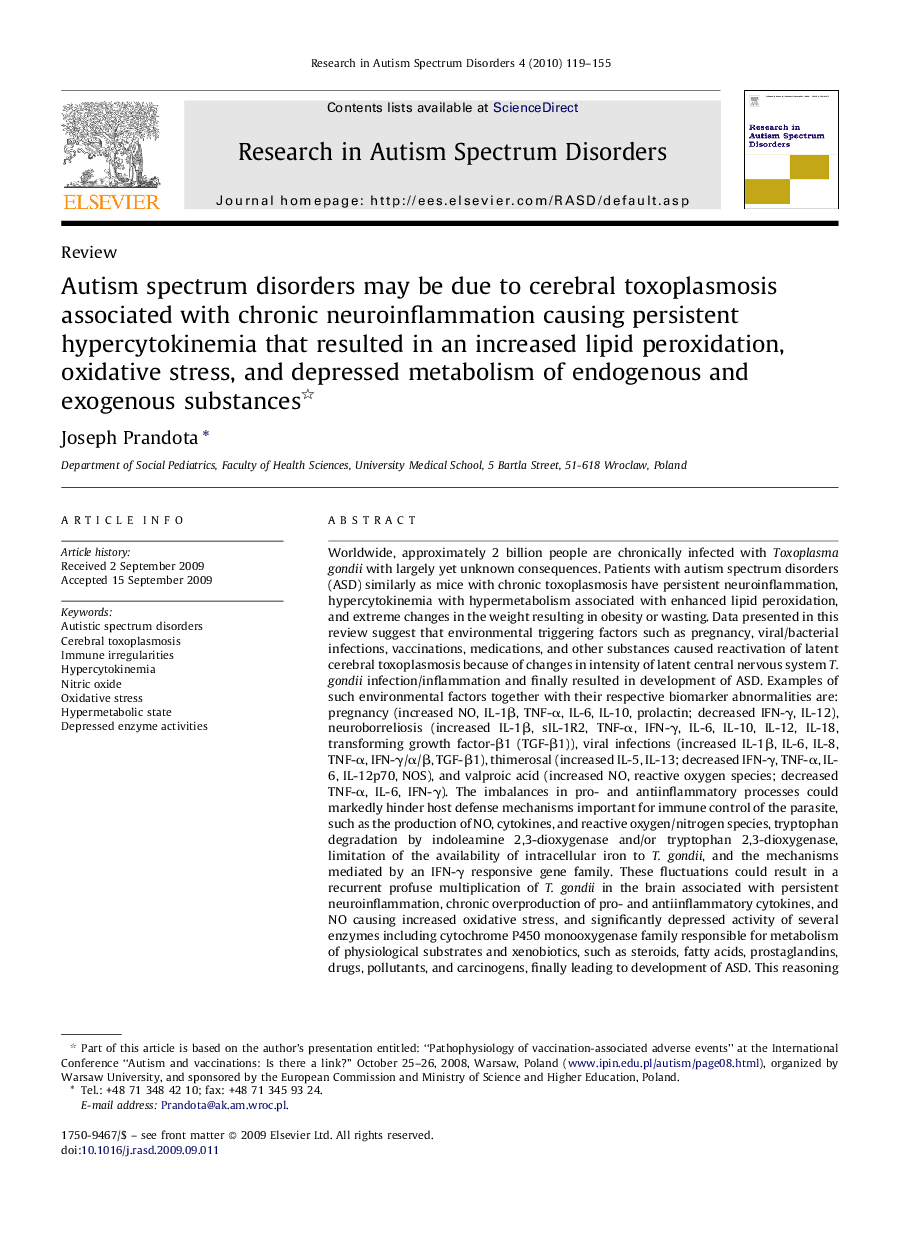| کد مقاله | کد نشریه | سال انتشار | مقاله انگلیسی | نسخه تمام متن |
|---|---|---|---|---|
| 370323 | 621858 | 2010 | 37 صفحه PDF | دانلود رایگان |

Worldwide, approximately 2 billion people are chronically infected with Toxoplasma gondii with largely yet unknown consequences. Patients with autism spectrum disorders (ASD) similarly as mice with chronic toxoplasmosis have persistent neuroinflammation, hypercytokinemia with hypermetabolism associated with enhanced lipid peroxidation, and extreme changes in the weight resulting in obesity or wasting. Data presented in this review suggest that environmental triggering factors such as pregnancy, viral/bacterial infections, vaccinations, medications, and other substances caused reactivation of latent cerebral toxoplasmosis because of changes in intensity of latent central nervous system T. gondii infection/inflammation and finally resulted in development of ASD. Examples of such environmental factors together with their respective biomarker abnormalities are: pregnancy (increased NO, IL-1β, TNF-α, IL-6, IL-10, prolactin; decreased IFN-γ, IL-12), neuroborreliosis (increased IL-1β, sIL-1R2, TNF-α, IFN-γ, IL-6, IL-10, IL-12, IL-18, transforming growth factor-β1 (TGF-β1)), viral infections (increased IL-1β, IL-6, IL-8, TNF-α, IFN-γ/α/β, TGF-β1), thimerosal (increased IL-5, IL-13; decreased IFN-γ, TNF-α, IL-6, IL-12p70, NOS), and valproic acid (increased NO, reactive oxygen species; decreased TNF-α, IL-6, IFN-γ). The imbalances in pro- and antiinflammatory processes could markedly hinder host defense mechanisms important for immune control of the parasite, such as the production of NO, cytokines, and reactive oxygen/nitrogen species, tryptophan degradation by indoleamine 2,3-dioxygenase and/or tryptophan 2,3-dioxygenase, limitation of the availability of intracellular iron to T. gondii, and the mechanisms mediated by an IFN-γ responsive gene family. These fluctuations could result in a recurrent profuse multiplication of T. gondii in the brain associated with persistent neuroinflammation, chronic overproduction of pro- and antiinflammatory cytokines, and NO causing increased oxidative stress, and significantly depressed activity of several enzymes including cytochrome P450 monooxygenase family responsible for metabolism of physiological substrates and xenobiotics, such as steroids, fatty acids, prostaglandins, drugs, pollutants, and carcinogens, finally leading to development of ASD. This reasoning may be supported by such abnormal metabolic events as: (1) patients with ASD have significantly decreased melatonin levels caused by marked deficit in acetylserotonin methyltransferase activity, possibly resulting from maternal and/or fetal/postnatal overproduction of NO, characteristic for this clinical entity; (2) thimerosal inhibited both insulin-like growth factor-1- and dopamine-stimulated methylation reactions, and depressed methionine synthase activity, the metabolic events important for promoting normal neurodevelopment; (3) valproic acid, a strong histone deacetylase inhibitor, have potent anti-T. gondii activity. Thus, patients with ASD should be tested for T. gondii infection.
Journal: Research in Autism Spectrum Disorders - Volume 4, Issue 2, April–June 2010, Pages 119–155